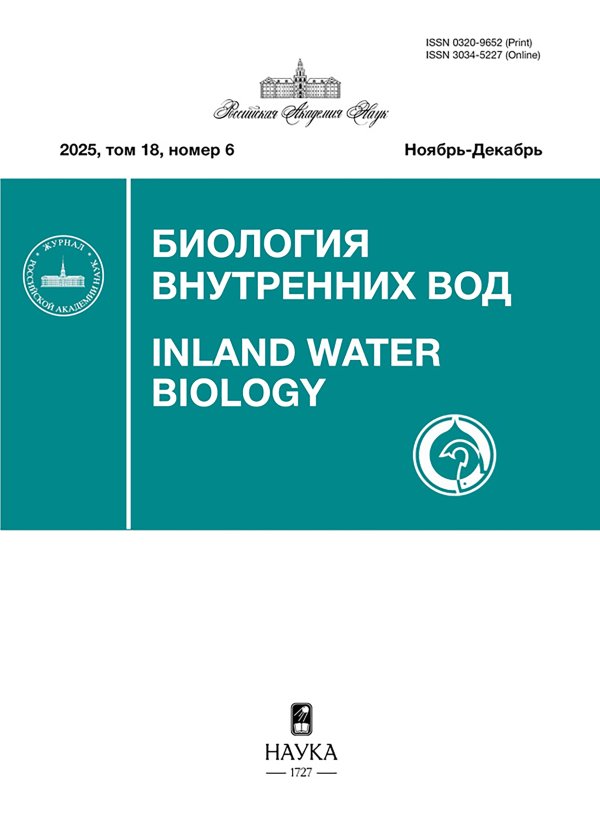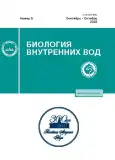Comparison of Olfactory Sensilla Structure in Littoral and Deep-Water Amphipods from the Baikal Region
- Authors: Shirokova Y.A.1, Saranchina A.E.1, Shatilina Z.M.1,2, Kashchuk N.D.1, Timofeyev M.A.1,2
-
Affiliations:
- Institute of Biology, Irkutsk State University
- Baikal Research Centre
- Issue: No 5 (2023)
- Pages: 660-670
- Section: Articles
- URL: https://journals.rcsi.science/0320-9652/article/view/134907
- DOI: https://doi.org/10.31857/S0320965223050145
- EDN: https://elibrary.ru/FAAEHM
- ID: 134907
Cite item
Full Text
Abstract
The structure of olfactory sensilla was compared in amphipods from the Baikal region, namely in nine Baikal species (Ommatogammarus carneolus melanophthalmus Bazikalova, 1945, O. flavus (Dybowsky, 1874), O. albinus (Dybowsky, 1874), Eulimnogammarus verrucosus (Gerstfeldt, 1858), E. vittatus (Dybowsky, 1874), E. cyaneus (Dybowsky, 1874), Acanthogammarus godlewskii (Dybowsky, 1874), Pallasea cancelloides (Gerstfeldt, 1858) and Gmelinoides fasciatus (Stebbing, 1899)) and a Holarctic species Gammarus lacustris Sars, 1863. The results of the study demonstrate the comparison of aesthetasc lengths and numbers, as well as SEM images of the aesthetascs for Baikal amphipods for the first time. Our results confirm and complement the previously obtained data on the number of aesthetascs per segment for three deep-water Baikal amphipod species of the genus Ommatogammarus. Within the studied deep-water amphipods with different habitat depth ranges, Ommatogammarus albinus (Dybowsky, 1874), inhabiting maximum habitat depth, had the highest number of aesthetascs. The size and number of aesthetascs did not differ in males and females of the littoral Eulimnogammarus verrucosus (Gerstfeldt, 1858) and deep-water species. The littoral amphipods were shown to have equipped with more mechanoreceptors antennae I than deep-water amphipods.
Keywords
About the authors
Y. A. Shirokova
Institute of Biology, Irkutsk State University
Author for correspondence.
Email: yuliashirokova2501@gmail.com
Russia, Irkutsk
A. E. Saranchina
Institute of Biology, Irkutsk State University
Email: yuliashirokova2501@gmail.com
Russia, Irkutsk
Zh. M. Shatilina
Institute of Biology, Irkutsk State University; Baikal Research Centre
Email: yuliashirokova2501@gmail.com
Russia, Irkutsk; Russia, Irkutsk
N. D. Kashchuk
Institute of Biology, Irkutsk State University
Email: yuliashirokova2501@gmail.com
Russia, Irkutsk
M. A. Timofeyev
Institute of Biology, Irkutsk State University; Baikal Research Centre
Email: yuliashirokova2501@gmail.com
Russia, Irkutsk; Russia, Irkutsk
References
- Базикалова А.Я. 1945. Амфиподы озера Байкал // Тр. Байкал. лимнол. ст. Т. 11. С. 1.
- Бедулина Д.С., Шатилина Ж.М., Гурков А.Н. 2018. Физиологические и биохимические маркеры стресс-ответа эндемичных байкальских амфипод: современное состояние и перспективы исследований // Изв. Иркутск. гос. ун-та. Серия: Биология. Экология. Т. 23. С. 3.
- Механикова И.В. 2002. О расположении эстетасков – антеннальных сенсорных органов у некоторых видов байкальских амфипод (Crustacea, Amphipoda) // Экологические, физиологические и паразитологические исследования пресноводных амфипод. Сб. научн. трудов. Иркутск: Иркут. ун-т. С. 83.
- Механикова И.В. 2021. Кальцеолы – антеннальные сенсорные органы амфипод (Crustacea, Amphipoda, Gammaridea) озера Байкал // Зоол. журн. Т. 100. № 2. С. 134.
- Русинек О.Т., Тахтеев В.В., Гладкочуб Д.П. и др. 2012. Байкаловедение. Новосибирск. Наука. Т. 2.
- Сидоров Д.А. 2012. Pseudocrangonyx kseniae, новый вид амфипод (Crustacea, Pseudocrangonyctidae) из подземных вод южного приморья // Зоол. журн. Т. 91. № 1. С. 30.
- Arfianti T. 2020. Biodiversity and biogeography of Amphipod Crustaceans // Doctoral dissertation. ResearchSpace. Auckland. Электронный ресурс [URL: https://researchspace.auckland.ac.nz/handle/2292/ 53402].
- Breithaupt T., Thiel M. 2011. Chemical Communication in Crustaceans // Springer Science and Business Media. New York.
- Derby C.D., Kozma M.T., Senatore A., Schmidt M. 2016. Molecular mechanisms of reception and perireception in crustacean chemoreception: a comparative review // Chemical Senses. V. 41. № 5. P. 381. https://doi.org/10.1093/chemse/bjw057
- Derby C., Thiel M. 2014. The Natural History of the Crustacea. V. 3. Nervous systems and control of behavior. USA: Oxford Univ. Press. P. 263.
- Gurkov A., Rivarola-Duarte L., Bedulina D. et al. 2019. Indication of ongoing amphipod speciation in Lake Baikal by genetic structures within endemic species // BMC Evolution. Biol. V. 19. P. 1. https://doi.org/10.1186/s12862-019-1470-8
- Hallberg E., Johansson K.U.I., Elofsson R. 1992. The aesthetasc concept: structural vatiations of putative olfactory receptor cell complexes in Crustacea // Microscopy Res. Tech. V. 22. № 4. P. 325. https://doi.org/10.1002/jemt.1070220403
- Jamieson A.J., Fujii T., Mayor D.J. et al. 2010. Hadal trenches: the ecology of the deepest places on Earth // Trends in Ecol. and Evol. V. 25. № 3. P. 190. https://doi.org/10.1016/j.tree.2009.09.009
- Jaume D., Cartes J.E., Sorbe J.C. 1998. A new species of Bathymedon Sars, 1892 (Amphipoda: Oedicerotidae) from the western Mediterranean bathyal floor // Sci. Mar. V. 62. № 4. P. 341.
- Johansson K.U.I., Hallberg E. 1992. Male-specific structures in the olfactory system of mysids (Mysidacea; Crustacea) // Cell and Tissue Res. V. 268. № 2. P. 359.
- Kamio M., Derby C.D. 2017. Finding food: how marine invertebrates use chemical cues to track and select food // Natural Product Reports. V. 34. № 5. P. 514. https://doi.org/10.1039/C6NP00121A
- Kassambara A. 2020. ggpubr: ‘ggplot2’ based Publication Ready Plots // R Package Version 0.4.0. 2020. [URL: https://CRAN.R-project.org/package=ggpubr].
- Katoh K., Standley D.M. 2013. MAFFT multiple sequence alignment software version 7: improvements in performance and usability // Mol. Biol. and Evol. V. 30. № 4. P. 772. https://doi.org/10.1093/molbev/mst010
- Kaufmann R.S. 1994. Structure and function of chemoreceptors in scavenging lysianassoid amphipods // J. Crustacean Biol. V. 14. № 1. P. 54. https://doi.org/10.1163/193724094X00470
- Laverack M.S. 1988. The diversity of chemoreceptors // Sensory biology of aquatic animals. New York: Springer. P. 287. https://doi.org/10.1007/978-1-4612-3714-3_11
- Minh B.Q., Schmidt H.A., Chernomor O. et al. 2020. IQ-TREE 2: new models and efficient methods for phylogenetic inference in the genomic era // Mol. Biol. and Evol. V. 37. № 5. P. 1530. https://doi.org/10.1093/molbev/msaa015
- Moskalenko V.N., Neretina T.V., Yampolsky L.Y. 2020. To the origin of lake baikal endemic gammarid radiations, with description of two new Eulimnogammarus spp. // Zootaxa. V. 4766. № 3. P. 457. https://doi.org/10.11646/zootaxa.4766.3.5
- Naumenko S.A., Logacheva M.D., Popova N.V. 2017. Transcriptome-based phylogeny of endemic Lake Baikal amphipod species flock: fast speciation accompanied by frequent episodes of positive selection // Mol. Ecol. V. 26. № 2. P. 536. https://doi.org/10.1111/mec.13927
- Okonechnikov K., Golosova O., Fursov M., Team U. 2012. Unipro UGENE: a unified bioinformatics toolkit // Bioinformatics. V. 28. № 8. P. 1166. https://doi.org/10.1093/bioinformatics/bts091
- Pravin S., Mellon D., Berger E.J., Reidenbach M.A. 2015. Effects of sensilla morphology on mechanosensory sensitivity in the crayfish // Bioinspir. Biomim. V. 10. № 3. P. 1. https://doi.org/10.1088/1748-3190/10/3/036006
- R Core Team. 2022. R: A language and environment for statistical computing // R Foundation for Statistical Computing. Vienna. Austria.
- Rivarola-Duarte L., Otto C., Jühling F. et al. 2014. A first glimpse at the genome of the Baikalian amphipod Eulimnogammarus verrucosus // J. Exp. Zool. Part B: Mol. and Develop. Evol. V. 322. № 3. P. 177. https://doi.org/10.1002/jez.b.22560
- Sainte-Marie B., Hargrave B.T. 1987. Estimation of scavenger abundance and distance of attraction to bait // Mar. Biol. V. 94. № 3. P. 431. https://doi.org/10.1007/BF00428250
- Schmidt M., Gnatzy W. 1984. Are the funnel-canal organs the ‘campaniform sensilla’ of the shore crab, Carcinus maenas (Decapoda, Crustacea)? // Cell and Tissue Res. V. 237. № 1. P. 81. https://doi.org/10.1007/BF00229202
- Schneider C.A., Rasband W.S., Eliceiri K.W. 2012. NIH Image to ImageJ: 25 years of image analysis // Nat. Meth. V. 9. № 7. P. 671. https://doi.org/10.1038/nmeth.2089
- Urbschat N., Scholtz G. 2019. Comparative analysis of the antennae of three amphipod species with different lifestyles // Arthropod Struct. and Develop. V. 53. P. 1. https://doi.org/10.1016/j.asd.2019.100886
- Vrijenhoek R. 1994. DNA primers for amplification of mitochondrial cytochrome c oxidase subunit I from diverse metazoan invertebrates // Mol. Mar. Biol. Biotechnol. V. 3. P. 294.
- Watling L., Thiel M. 2013. The Natural History of the Crustacea. V. 1. Functional morphology and diversity. USA: Oxford Univ. Press.
- Wickham H. 2016. ggplot2: Elegant Graphics for Data Analysis. Berlin: Springer.
- Yu G., Smith D.K., Zhu H. et al. 2017. ggtree: an R package for visualization and annotation of phylogenetic trees with their covariates and other associated data // Methods in Ecol. and Evol. V. 8. № 1. P. 28. https://doi.org/10.1111/2041-210X.12628
Supplementary files
















